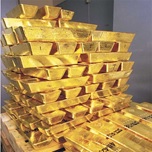Will Gold Prices Surge Higher After The Best Start To The Year Since The 1980 Spike?
 After the best start to the year since 1980 when gold prices quadrupled, and the best week for the gold price in four years with a decisive breakout from the bear market, this is an exciting point to be reviewing the now transformed outlook for gold in 2016.
After the best start to the year since 1980 when gold prices quadrupled, and the best week for the gold price in four years with a decisive breakout from the bear market, this is an exciting point to be reviewing the now transformed outlook for gold in 2016.
What will happen next week? The Chinese will return from their New Year’s holiday and presumably catch up with the global equity sell-off of last week. Turning this cash into gold as a currency without the shadow of devaluation hanging over it would make excellent sense.
Oil prices
Last Friday, however, it was not the small pullback in the gold price from $1,264 to $1,234 an ounce that really caught my eye but the 11 per cent surge in oil prices. This looks to me a solid recovery after a double bottom for prices, just like the one gold put in six weeks ago.
It is also supported by fundamentals. The UAE Oil Minister said a deal to cut supply was now on the table. I live in Dubai and know these guys. This is most probably not hot air but an honest statement of where negotiations have now gotten to.
If the oil price now recovers strongly then that will also be very good news for gold. These two hard commodities generally move upwards together. Think back to what happened in 1980 when the Iranian Revolution produced a massive spike in oil prices and gold prices last went to the moon.
Of course, the rest of the world was still plunged into a deep recession and stock markets entered a deep bear market. There is no hiding from economic reality in such circumstances.
Central banks
Central banks will respond in the only way that they know how: cutting interest rates, buying bonds and stimulating as far as they can. Consider what the Bank of Japan did recently, setting off the slump in global stocks, and the Swedish central bank put its interest rates further into negative territory last week.
Confidence in paper money is getting shot to pieces. It is going to get worse. Holders of 10-year US treasuries have seen their safe yields slump from 2.3 to as low as 1.57 per cent since the start of the year.
That’s a nice profit for bond holders but it is not much of a return for the risk of a reaction in the opposite direction. It also undermines the investment case against gold.
Gold is supposed to be a bad choice of asset class when interest rates are rising because it does not pay a dividend or yield. However, when interest rates are falling (and what is the 10-year yield now doing?) then gold becomes an increasingly attractive proposition.
Bond markets
Besides where do you turn to for a safe haven asset class when stock markets and other commodity markets are in such chaos. Bonds with negative interest rates? The bonds of corporates and countries heading for bankruptcy? Distressed debt?
Precious metals have become the obvious choice as a safe haven, especially now that the bear market has been so decisively broken. It is amusing to note chartists like Avi Gilbert who failed to actually call the gold market bottom now beginning to peddle their services as an infallible guide to spotting the market top.
But it is a sign of just how much the precious metals’ market has changed since the New Year, and that sticking with it, as this column suggested, was exactly the right thing to do. Those who waited, and are perhaps still waiting for gold to fall below $1,000 an ounce, have missed the rally of a lifetime, and one that is not over yet.
Oil and gold will now mostly likely move up in tandem. Even a doubling of oil prices from present levels would still leave the price almost half of its high in 2014. Oil prices have the potential to quadruple over the next 18 months and so does the price of gold.
$5,000 gold?
The past four years have just been a correction on ‘The Road to $5,000 Gold’ as I subtitled my last book published in 2010 when gold last looked to be on the way to much higher prices. It proved to be a much longer and harder road than I thought at that time but I’ve got given up on gold at any stage.
Why? Well it was not just a stubborn disposition and inability to think I am wrong. My reasoning was simply that the great gold market of the 1970s also saw a bad stumble and consolidation from 1975-6 before the spike to the top in 1980.
Indeed, it was the absence of this final spike in the gold market of the 2000s that made me so sure that the top was not in for the price. Let us not forget the rule that long bull markets in commodities always end in an exponential spike.
Commodities veteran Jim Rogers whose book ‘Hot Commodities’ correctly called the new bull market at the end of the 90s is always pointing this out whenever interviewed about gold, though sadly he’s been waiting for the correction to go below $1,000 to buy more of the precious metal. Perhaps he should have been happy with a 50 per cent retrenchment of the bull market gains that took us to almost exactly $1,050 which marked a classic double bottom.
Rocket to the moon
But don’t expect gold to head like a rocket ship to the moon. The trajectory of market prices always looks more like a jagged mountain side with price overshoots, backfilling and retrenchment before further advances.
Nonetheless, the final stage of the ascent should be very clear even to the most amateur chartist as it will look like a vertical rocket going up: 2016 could get to be another 1980 or we could have to wait another year.
That this year has begun with a report of price performance not seen since the last epic price movement in gold ought to tell us something. History does not always repeat itself but as Mark Twain said it does rhyme.

















